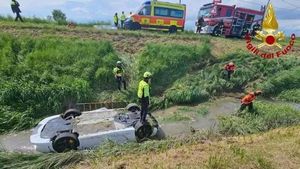Southern California is grappling with the aftermath of intense wildfires, which ignited due to extreme weather conditions exacerbated by climate change. This region recently witnessed fires so destructive they killed at least 29 people and destroyed over 16,000 buildings, including homes and schools. Experts reveal the probability of such devastating weather conditions has risen by 35% due to human-induced global warming.
The World Weather Attribution group, which evaluates climate change's impact on events, stated during a press conference, "This was a perfect storm when it came to conditions for fire disasters — the ingredients in terms of the climate enabling, the weather driving the fires and the huge built environment right downwind from where these ignitions occurred." This analysis aligns with the current scientific discourse linking greater wildfire risks to increasingly arid climates and extended fire seasons.
On January 7, the wildfires began amid high winds and dry conditions, part of the larger picture of changing climate patterns. The group detailed how, compared to pre-industrial times, Southern California now experiences 23 additional days of dry season each year, making it more susceptible to fire incidents, especially aligned with seasonal Santa Ana winds.
Another side effect of the fires is the dilemma surrounding hazardous waste management post-blazes. Residents from Duarte and nearby areas have expressed fierce opposition to the use of Lario Park as a temporary site for processing debris contaminated by hazardous materials from the wildfires. Ceci Carroll, a long-time local resident, voiced her concerns during community meetings, stating, "We’re dealing with the site with the chemicals and hazardous materials. Parents are absolutely concerned." Community fears echo throughout Duarte, Azusa, and nearby cities as the Environmental Protection Agency (EPA) coordinates the cleanup efforts.
The EPA anticipates removing hundreds of tons of hazardous materials, which include paints, pesticides, and lithium-ion batteries, from the affected areas. Los Angeles County Supervisor Hilda Solis emphasized the need for careful handling of hazardous materials, stating, "The removal of these materials should not come at the cost of creating a toxic environment for communities already disproportionately impacted by pollution." These communities, largely comprised of Latino residents, face existing environmental health risks and are rightfully wary of new pollution sources.
Residents raised pointed questions during town hall meetings, demanding accountability for how the waste site was selected, why they weren’t consulted, and what measures would be taken to monitor safety. Concerns about contaminant leaks and air quality post-cleanup remain at the forefront, with experts advocating for transparency and rigorous oversight during the EPA's taming of hazardous debris.
While experts assured residents about the protocols for pollution containment, anxiety persisted. Sanjay Mohanty, UCLA associate professor, explained the low likelihood of groundwater contamination due to layers of soil filtering out pollutants, but acknowledged the bigger risks revolve around soil and air pollution from dust emissions. "Residents should stay vigilant," he cautioned, urging continued community engagement with the cleanup process.
Many residents across affected areas are still grappling with trust issues surrounding state agencies. Laura Jasso, another Duarte resident, said, "It’s hard to have confidence when they’ve really done this behind our backs," echoing sentiments common among those impacted by the recent fires. Jasso and others advocate for stringent safety measures and protection of their community's health.
The fires exposed not just the immediate popularity of wildfires but the intertwined web of climate dynamics, community safety, and government responsibility. Climate scientists, including John Abatzoglou from UC Merced, clarified how the conditions creating these disasters are growing more severe. He explained, "The artificial warming due to human-caused climate change is making the light brighter," referring to the fire risk conditions as individual switches needed to be activated for disaster scenarios.
Even as firefighters battled the blazes, their concerns about job security arose amid discussions of workforce reductions within federal firefighting agencies. Many firefighters, already underpaid, faced uncertainty following alarming emails hinting at potential cuts, compounding the strain on community safety and emergency responses. How could the federal government assure adequate protections when those committed to battling the fires were left questioning their futures?
These disasters showcase the challenges of firefighting amid the climate crisis, emphasizing the need for consolidated action between government agencies and local communities. The environmental consequences spill beyond the immediate aftermath of the fires, illustrating how climate change influences not only weather patterns but also the social fabric of communities impacted by its wrath.
The intersection between climate change and the rising toll of wildfires resonates loudly, highlighting not just scientific acknowledgment but the pressing need for preventive action and community resilience. Long-term solutions must be pursued, ranging from comprehensive urban planning and enforced preventive measures to successful community engagement if these fires are to become less frequent and destructive.
Only by addressing climate change at the systemic level can Southern California hope to mitigate the impacts of devastating wildfires and protect the communities caught in the crossfire.



